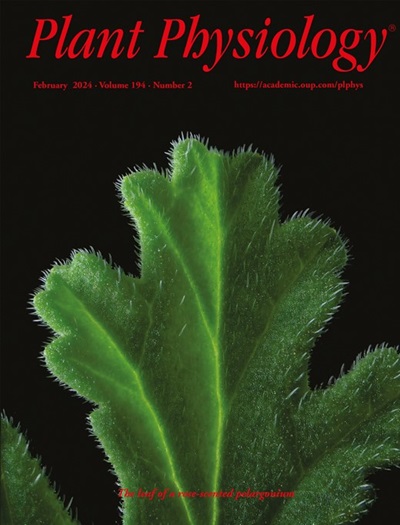茉莉酸信号和谷胱甘肽协调植物从强光胁迫中恢复
IF 6.5
1区 生物学
Q1 PLANT SCIENCES
引用次数: 0
摘要
强光诱导的叶绿体逆行信号源于光合机构,通过调控细胞核基因表达来增强光保护和协调细胞代谢。在此,我们分析了HL胁迫下,特别是生长光照条件下植物恢复过程中ROS、胁迫激素和小分子抗氧化剂的转录谱和积累情况,以探讨HL胁迫下的信号传导机制。拟南芥(Arabidopsis thaliana)莲座暴露在HL中15分钟,诱导了几个10o2和h2o2响应基因,并积累了氧化形式的谷胱甘肽,这是细胞氧化应激的标志。长期暴露于HL导致编码氧脂素生物合成酶的转录物积累,导致12-氧-植物二烯酸和茉莉酸的积累。然而,已经被HL诱导的几个茉莉酸应答基因的表达在恢复期间达到峰值,同时茉莉酸和还原性谷胱甘肽和抗坏血酸的积累,突出了茉莉酸信号在HL胁迫后恢复叶绿体氧化还原平衡中的关键作用。通过对茉莉酸受体突变体的实验,进一步证实了茉莉酸信号在恢复持续基因表达中的作用。HL暴露仅2分钟就足以诱导一些持续恢复的基因,这表明植物对变化的光照条件反应迅速。我们认为,HL中ROS的产生诱导了早期氧化脂素生物合成和12-氧-植物二烯酸积累的信号级联,而恢复阶段茉莉酸积累的增加激活了完全恢复谷胱甘肽代谢的基因,最终使HL短期应激恢复。本文章由计算机程序翻译,如有差异,请以英文原文为准。
Jasmonic acid signaling and glutathione coordinate plant recovery from high light stress
High light (HL)-induced chloroplast retrograde signaling originates from the photosynthetic apparatus and regulates nuclear gene expression to enhance photoprotection and coordination of cell metabolism. Here, we analyzed the transcript profiles and accumulation of ROS, stress hormones, and small molecule antioxidants to investigate the signaling mechanisms operating under HL stress, particularly during plant recovery under growth light condition. Exposure of Arabidopsis (Arabidopsis thaliana) rosettes to HL for 15 min induced several 1O2- and H2O2-responsive genes and accumulation of an oxidized form of glutathione, the hallmarks of oxidative stress in cells. Prolonged exposure to HL resulted in accumulation of transcripts encoding oxylipin biosynthesis enzymes, leading to accumulation of 12-oxo-phytodienoic acid and jasmonic acid. However, the expression of several jasmonic acid-responsive genes, already induced by HL, peaked during the recovery, together with accumulation of jasmonic acid and reduced glutathione and ascorbate, highlighting the critical role of jasmonic acid signaling in restoring chloroplast redox balance following HL stress. The involvement of jasmonic acid signaling in recovery-sustained gene expression was further confirmed via experiments with jasmonic acid receptor mutants. HL exposure of only 2 min was sufficient to induce some recovery-sustained genes, indicating the rapid response of plants to changing light conditions. We propose that ROS production at HL induces the signaling cascade for early oxylipin biosynthesis and 12-oxo-phytodienoic acid accumulation, while increased accumulation of jasmonic acid in the recovery phase activates genes that fully restore the glutathione metabolism, ultimately allowing recovery from short-term HL stress.
求助全文
通过发布文献求助,成功后即可免费获取论文全文。
去求助
来源期刊

Plant Physiology
生物-植物科学
CiteScore
12.20
自引率
5.40%
发文量
535
审稿时长
2.3 months
期刊介绍:
Plant Physiology® is a distinguished and highly respected journal with a rich history dating back to its establishment in 1926. It stands as a leading international publication in the field of plant biology, covering a comprehensive range of topics from the molecular and structural aspects of plant life to systems biology and ecophysiology. Recognized as the most highly cited journal in plant sciences, Plant Physiology® is a testament to its commitment to excellence and the dissemination of groundbreaking research.
As the official publication of the American Society of Plant Biologists, Plant Physiology® upholds rigorous peer-review standards, ensuring that the scientific community receives the highest quality research. The journal releases 12 issues annually, providing a steady stream of new findings and insights to its readership.
 求助内容:
求助内容: 应助结果提醒方式:
应助结果提醒方式:


